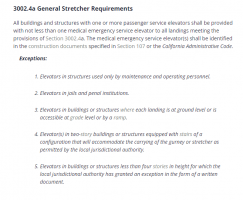I've been thinking about this more regarding the California version of the IEBC, and I'm not sure I agree that it triggers elevator enlargement:
A change of occupancy shall not be made in any building unless that building is made to comply with the
requirements of the
California Building Code for the use or occupancy. Changes of occupancy in a building or portion thereof shall be such that the existing building is
not less complying with the provisions of this code than the existing building or structure was prior to the change. Subject to the approval of the
code official, changes of occupancy shall be permitted without complying with all of the requirements of this code for the new occupancy, provided that the new occupancy is less hazardous, based on life and fire risk, than the existing occupancy.
Two observations:
1. The phrase "requirements...
for the use or occupancy" seems focused on "requirements based on occupancy". 3002.4a is a requirements for features of an (new) elevator and have no relation to the type of occupancy or change of occupancy. An elevator is not required to have a legally occupiable 3-story apartment building.
2. Even if you conclude that 506.1 may apply to based on occupancy, in my particular case, apartments are generally (IMO) not an increase in hazard as it relates to the need for a gurney. There are sleeping rooms, just like at the former hotel, whether the sleeping is less than or greater than 30 days. In fact, one could argue that permanent residents are more familiar with the means of egress than hotel guests. And in any case, the gurney is not for resident means of egress or other fire/life safety issues, it is an aid for medical personnel.


